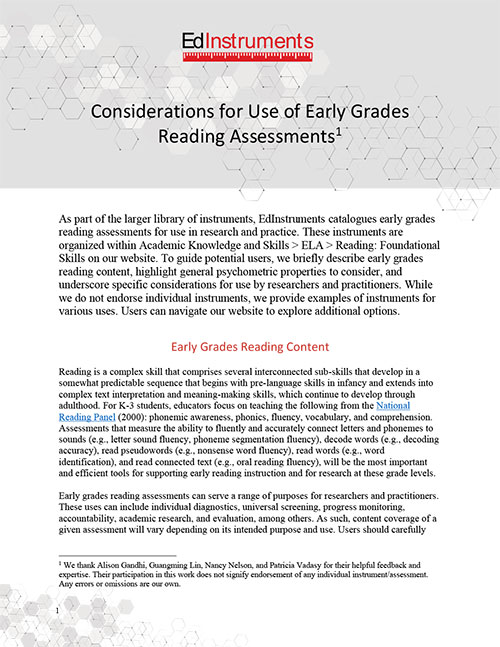
As part of the larger library of instruments, EdInstruments catalogues early grades reading assessments for use in research and practice. These instruments are organized within Academic Knowledge and Skills > ELA > Reading: Foundational Skills on our website. To guide potential users, we briefly describe early grades reading content, highlight general psychometric properties to consider, and underscore specific considerations for use by researchers and practitioners. While we do not endorse individual instruments, we provide examples of instruments for various uses. Users can navigate our website to explore additional options.
Early Grades Reading Content
Reading is a complex skill that comprises several interconnected sub-skills that develop in a somewhat predictable sequence that begins with pre-language skills in infancy and extends into complex text interpretation and meaning-making skills, which continue to develop through adulthood. For K-3 students, educators focus on teaching the following from the National Reading Panel (2000): phonemic awareness, phonics, fluency, vocabulary, and comprehension. Assessments that measure the ability to fluently and accurately connect letters and phonemes to sounds (e.g., letter sound fluency, phoneme segmentation fluency), decode words (e.g., decoding accuracy), read pseudowords (e.g., nonsense word fluency), read words (e.g., word identification), and read connected text (e.g., oral reading fluency), will be the most important and efficient tools for supporting early reading instruction and for research at these grade levels.
Early grades reading assessments can serve a range of purposes for researchers and practitioners. These uses can include individual diagnostics, universal screening, progress monitoring, accountability, academic research, and evaluation, among others. As such, content coverage of a given assessment will vary depending on its intended purpose and use. Users should carefully consider their needs and ensure this aligns with the intended purpose of the assessment and the appropriate grade-level learning objectives.